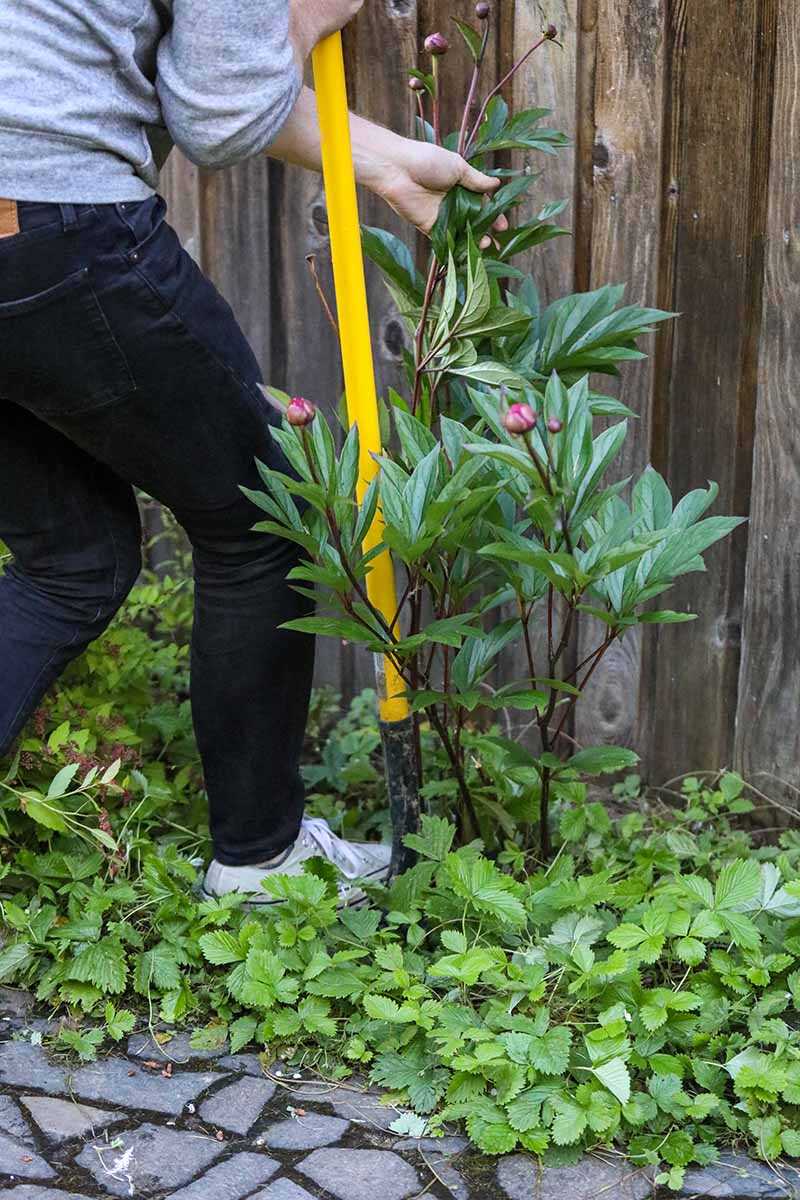- Choosing the Right Variety
- Selecting the Perfect Location
- Sunlight
- Soil
- Space
- Protection
- Aesthetics
- Preparing the Soil
- 1. Choose the Right Location
- 2. Test the Soil
- 3. Improve the Soil Structure and Drainage
- 4. Amend the Soil pH
- 5. Remove Weeds and Debris
- 6. Dig a Suitable Planting Hole
- 7. Add Fertilizer
- 8. Water the Soil
- 9. Create a Mound in the Planting Hole
- 10. Prepare the Peony Tubers or Divisions
- 11. Plant the Peonies
- 12. Water and Mulch
- Planting Peonies
- Site Selection
- Preparing the Soil
- Planting Depth
- Planting Instructions
- Care and Maintenance
- Watering and Fertilizing
- Transplanting Peonies
- 1. Timing
- 2. Preparation
- 3. Uprooting
- 4. Division
- 5. Replanting
- 6. Watering and Mulching
- 7. Care after Transplant
- Propagation Methods
- 1. Division
- 2. Seed Propagation
- 3. Root Cuttings
- Pruning and Maintenance Tips
- 1. Prune at the right time
- 2. Remove spent blooms
- 3. Support the stems
- 4. Mulch and water regularly
- 5. Fertilize appropriately
- 6. Monitor for pests and diseases
- Questions and Answers:
- When is the best time to plant peonies?
- Can I transplant peonies?
- How deep should I plant my peonies?
- How do I propagate peonies?
- What are some common issues with peonies?
- What are the different types of peonies?
- How long does it take for peonies to bloom?
- Videos: PEONY PROPAGATION | CARE FOR THE PLANT, REJUVENATION
If you’re looking to add beauty and elegance to your garden, look no further than peonies. These stunning flowers, known for their large, showy blooms, come in a variety of colors and can transform any outdoor space into a vibrant oasis. Whether you’re a seasoned gardener or just starting out, this article will provide you with expert tips and techniques for planting, transplanting, and propagating peonies.
Planting peonies requires careful consideration of location and soil conditions. These perennial flowers prefer well-draining soil and full sun, so choose a spot in your garden that receives at least six hours of direct sunlight daily. The soil should be rich and fertile, with a pH level between 6.5 and 7.5. It’s essential to prepare the soil before planting by removing any weeds or grass and amending it with organic matter, such as compost or aged manure.
Transplanting peonies can be done in either spring or fall, but spring is generally the preferred time. When transplanting, it’s important to dig up the entire root system without damaging the delicate buds. Be sure to choose a location with similar soil conditions to the original planting spot, and follow the same steps for preparing the soil. After transplanting, water the peonies thoroughly and continue to water regularly until they become established in their new location.
Propagation is another way to expand your peony collection. You can propagate peonies through division, which involves separating the plant into smaller sections with at least three to five eyes (buds) each. This is best done in the fall when the peony is dormant. Gently lift the plant out of the ground, and use a sharp knife or spade to divide the clump. Replant the divisions in the prepared soil, making sure to space them at least three feet apart to allow for proper airflow.
“Peonies are a beloved flower, cherished for their beauty and fragrance. With proper planting, transplanting, and propagation, you can enjoy these stunning blooms for many years to come.”
In summary, peonies are a timeless addition to any garden. By following these expert tips and techniques for planting, transplanting, and propagating peonies, you’ll be able to cultivate a gorgeous display of these captivating flowers. So go ahead and bring the beauty of peonies into your own backyard!
Choosing the Right Variety
When it comes to growing peonies, choosing the right variety is important. There are many different types of peonies available, each with its own unique characteristics and growing requirements. Here are some factors to consider when selecting a peony variety:
- Flower Type: Peonies come in a variety of flower types, including single, semi-double, double, bomb, and anemone. Each flower type has its own distinct look and appeal, so choose one that suits your preferences.
- Flower Color: Peonies come in a wide range of colors, including white, pink, red, purple, yellow, and bicolor. Consider the color scheme of your garden or landscape when choosing a peony variety.
- Blooming Time: Different peony varieties bloom at different times during the growing season. Some varieties bloom early in the season, while others bloom later. Consider the desired bloom time to create a continuous display of peonies throughout the season.
- Plant Size: Peonies come in various sizes, ranging from dwarf varieties that reach only a few inches in height to tall varieties that can grow up to 4 feet or more. Consider the available space in your garden and choose a variety that fits the desired location.
- Growth Habit: Peonies can have different growth habits, including herbaceous (dying back to the ground in winter) and tree peonies (woody stems that remain through winter). Consider the growth habit that suits your garden and maintenance preferences.
It’s also important to consider the climate and growing conditions in your area when selecting a peony variety. Some varieties are more cold hardy, while others prefer warmer climates. Additionally, peonies require well-draining soil and full sun to bloom their best, so choose a variety that is suitable for your specific conditions.
By considering these factors and doing some research on the different peony varieties available, you can choose the right variety that will thrive in your garden and provide you with beautiful blooms for years to come.
Selecting the Perfect Location
Choosing the right location for your peonies is crucial to their growth and blooming success. Here are some key factors to consider when selecting the perfect location:
Sunlight
Peonies thrive in full sun, so it is important to choose a location that receives at least 6-8 hours of direct sunlight per day. Avoid planting them in shady or partially shaded areas, as this can result in poor flowering.
Soil
Peonies prefer well-draining soil that is rich in organic matter. They do best in loamy or sandy soils with a pH level between 6.5 and 7.5. Before planting, it is recommended to amend the soil with compost or well-rotted manure to improve its fertility and drainage.
Space
Peonies need adequate space to grow and spread, so choose a location that allows them room to expand. Avoid planting them too close to other plants, as this can lead to overcrowding and competition for nutrients and water. Allow at least 3-4 feet of space between each peony plant.
Protection
Consider the protection provided by nearby structures or plants. Peonies can benefit from some protection against strong winds, as their large flowers and soft stems can be easily damaged. Planting them near a wall, fence, or other sturdy plants can help provide some shelter.
Aesthetics
Lastly, consider the aesthetic appeal when selecting the location for your peonies. These beautiful flowers can become a focal point in your garden, so choose a spot where they can be admired and enjoyed. Planting them near other colorful flowers or in a prominent area can enhance their visual impact.
By considering these factors and selecting the perfect location for your peonies, you can ensure that they thrive and reward you with stunning blooms year after year.
Preparing the Soil
1. Choose the Right Location

Peonies thrive in well-drained soil with full sun exposure. Choose a location that receives at least 6-8 hours of direct sunlight each day and has good drainage to prevent water-logging.
2. Test the Soil
Before planting peonies, it’s essential to test the soil to determine its pH level. Peonies prefer slightly acidic soil with a pH between 6.0 and 7.0. You can use a soil testing kit available at gardening centers or send a sample to a local agricultural extension office for analysis.
3. Improve the Soil Structure and Drainage
If the soil is heavy and clayey, it can retain water and cause root rot. To improve the soil structure and drainage, add organic matter such as compost, well-rotted manure, or peat moss. Mix it thoroughly with the existing soil to a depth of about 12 inches.
4. Amend the Soil pH

If the soil pH is not in the desired range, you can amend it accordingly. To lower the pH and make the soil more acidic, add elemental sulfur or aluminum sulfate. To raise the pH and make the soil more alkaline, add ground limestone or wood ash. Follow the package instructions for the proper application rates.
5. Remove Weeds and Debris

Prior to planting, remove any weeds, rocks, or debris from the planting area. This will create a clean and weed-free space for your peonies to grow without competition for nutrients and water.
6. Dig a Suitable Planting Hole

Dig a hole that is about 2 feet deep and 2 feet wide. Loosen the soil in the hole with a garden fork or a spade. This will help the roots penetrate the soil easily and establish a strong root system.
7. Add Fertilizer
Before planting, mix a balanced slow-release fertilizer into the soil at the bottom of the planting hole. This will provide essential nutrients to the peonies as they establish and grow. Follow the package instructions for the appropriate amount of fertilizer to use.
8. Water the Soil
A few hours before planting, water the soil in the planting hole thoroughly. This will ensure that the soil is well-moistened before planting and will help the peony roots establish quickly after planting.
9. Create a Mound in the Planting Hole

In the center of the planting hole, create a small mound using the backfill soil. This will help prevent water from pooling around the roots and promote better drainage.
10. Prepare the Peony Tubers or Divisions
If you are planting peony tubers or divisions, make sure to soak them in water for a few hours before planting. This will hydrate the root system and improve the chances of successful establishment.
11. Plant the Peonies
Place the peony tubers or divisions on top of the mound in the planting hole, spreading the roots out evenly. Make sure that the eyes (buds) are facing upwards and are about 2 inches below the soil surface. Backfill the hole with soil, gently firming it around the roots.
12. Water and Mulch
After planting, water the peonies thoroughly to settle the soil and eliminate any air pockets around the roots. Apply a layer of organic mulch, such as straw or wood chips, around the plants. This will help conserve moisture, suppress weed growth, and insulate the soil.
By following these soil preparation steps, you can ensure that your peonies have the best possible start for healthy growth and abundant blooms.
Planting Peonies
Site Selection
When planting peonies, it is important to choose the right site for them to thrive. Peonies prefer a location with full sun or partial shade, at least 6 hours of direct sunlight a day is ideal. The soil should be well-drained and rich in organic matter. Peonies also benefit from good air circulation, so avoid planting them too close to other plants or structures.
Preparing the Soil

Before planting peonies, it is essential to prepare the soil properly. Start by removing any weeds or grass from the area where you plan to plant them. Dig the soil to a depth of about 12 inches, and mix in compost or well-rotted manure to improve the soil’s fertility and drainage.
Planting Depth
When planting peonies, it is crucial to get the depth right. The eyes, or growing buds, should be planted no more than 2 inches below the soil surface. Planting too deep may result in poor blooming or no blooming at all. Be sure to position the eyes facing upwards to ensure proper growth.
Planting Instructions

- Dig a hole that is wide and deep enough to accommodate the peony root system comfortably.
- Place the peony root in the hole, making sure the eyes are facing upwards.
- Backfill the hole with soil, gently firming it around the root system.
- Water the newly planted peony thoroughly.
- Apply a layer of mulch around the plant to help conserve moisture and suppress weed growth.
Care and Maintenance

After planting, peonies require minimal care and maintenance. Regular watering is important, especially during dry periods. Avoid overwatering, as peonies are prone to rot if the soil becomes waterlogged. Fertilize the plants in early spring with a balanced fertilizer to promote healthy growth and abundant blooms. Deadhead the faded flowers to encourage new blooms and improve the overall appearance of the plant.
Watering and Fertilizing
Watering is an important aspect of growing healthy peonies. Peonies need a consistent supply of water, especially during the growing season and while they are developing buds. However, it’s important not to overwater peonies, as their roots can rot if they sit in excessively wet soil.
Here are some tips for watering peonies:
- Water peonies deeply once a week during dry periods.
- Avoid getting the foliage wet when watering, as this can increase the risk of fungal diseases.
- Water in the morning or early evening to minimize water loss through evaporation.
- Avoid overhead irrigation, such as sprinklers, as it can also increase the risk of fungal diseases.
In terms of fertilizing, peonies generally don’t require a lot of fertilization. However, providing some nutrients can help them grow and bloom more vigorously.
Here are some tips for fertilizing peonies:
- Apply a balanced organic fertilizer, such as a 10-10-10 or 5-10-5 formula, in early spring before new growth starts.
- Apply the fertilizer around the base of the peony plants, being careful not to get it on the foliage.
- Avoid placing excessive amounts of fertilizer, as this can lead to weak stems and fewer flowers.
- After applying the fertilizer, water the plants thoroughly to distribute the nutrients.
- Avoid fertilizing peonies in late summer or fall, as this can encourage late-season growth that may not have time to harden off before winter.
By following these watering and fertilizing tips, you can ensure that your peonies thrive and produce beautiful blooms.
Transplanting Peonies
Transplanting peonies can be done to divide and propagate the plants, or to move them to a more suitable location in the garden. Here are some expert tips and techniques for successful peony transplanting:
1. Timing
The best time to transplant peonies is in the fall, after the foliage has died back. This is usually in September or October, depending on your climate. Transplanting in the fall allows the roots to establish before the dormant winter period.
2. Preparation
Before transplanting, prepare the new planting location by digging a hole that is wide enough and deep enough to accomodate the peony root ball. Make sure the soil is well-draining and amend with compost if needed.
3. Uprooting
Carefully dig around the base of the peony plant, trying to keep the root ball intact. Use a garden fork or spade to gently lift the plant out of the ground, being careful not to damage the roots.
4. Division
If you are dividing the peony plant, you can carefully separate the clumps of roots. Each division should have at least 3-5 “eyes” – the buds on the roots that will develop into new shoots. Trim any damaged or diseased roots before replanting.
5. Replanting
Place the peony root ball or divided plants into the prepared hole, making sure that the eyes are facing upwards. The eyes should be 1-2 inches below the soil surface. Backfill the hole with soil, gently firming it around the roots.
6. Watering and Mulching
After transplanting, water the peonies thoroughly to help settle the soil and reduce transplant shock. Apply a layer of mulch around the plants to retain moisture and suppress weeds.
7. Care after Transplant
Keep the newly transplanted peonies well-watered, especially during dry periods. Avoid planting them too deeply or over-fertilizing, as this can inhibit blooming. Peonies may take a year or two to fully recover and start blooming again after being transplanted.
By following these tips and techniques, you can successfully transplant peonies and enjoy their beautiful flowers in a new location or share them with others through propagation.
Propagation Methods
There are several methods that can be used to propagate peonies. Here are some of the most commonly used techniques:
1. Division
Division is the most common and easiest way to propagate peonies. It involves digging up an established plant and dividing the clump into smaller sections, each with its own set of roots and buds. Division should be done in early spring or fall, when the plant is dormant. Here are the steps for dividing peonies:
- Using a garden fork or shovel, carefully dig up the entire plant, taking care not to damage the roots.
- Shake off the excess soil and examine the clump. Look for naturally occurring divisions or separate the clump into smaller sections by cutting through the fleshy roots with a sharp knife or spade.
- Make sure each divided section has at least 3 to 5 buds and a healthy set of roots.
- Replant the divisions in a sunny location with well-draining soil. Dig a hole large enough to accommodate the roots, position the division in the hole, and backfill with soil, making sure the buds are placed just below the soil surface.
- Water the newly planted divisions thoroughly and keep the soil evenly moist until they are established.
2. Seed Propagation
Peonies can also be propagated from seeds, but this method is less commonly used as it takes longer and usually results in a less predictable outcome in terms of flower color and form. Here is how to propagate peonies from seeds:
- Collect mature seeds from the peony plant in late summer or early fall, after the seed pods have dried and started to split open.
- Clean the seeds by removing any remaining seed pod material and place them in a container with slightly moist peat moss or vermiculite. Mix well to ensure the seeds are surrounded by the moist medium.
- Place the container in the refrigerator and stratify the seeds by keeping them in cold, moist conditions for about 8 to 12 weeks. This will help break the seed’s dormancy and promote germination.
- After stratification, sow the seeds in pots or trays filled with a well-draining seed starting mix. Press the seeds lightly into the soil and cover with a thin layer of the mix.
- Water the seeds and place the pots or trays in a warm, bright location, but out of direct sunlight. Keep the soil consistently moist, but not waterlogged.
- The seeds should germinate within a few weeks to a few months, depending on the variety. Once the seedlings have developed several sets of true leaves, they can be transplanted into individual pots or directly into the garden.
3. Root Cuttings

Root cuttings are another method used to propagate peonies, especially for varieties that do not produce viable seeds. Here is how to propagate peonies from root cuttings:
- In late fall or early spring, dig up the plant and cut the thick, fleshy roots into sections about 4 to 6 inches long.
- Make sure each cutting has at least one bud and several smaller roots attached.
- Prepare a well-draining potting mix and fill a container with it.
- Place the root cuttings horizontally on the soil surface, with the bud facing up, and press them lightly into the soil.
- Water the cuttings and place the container in a cool, shaded area. Keep the soil evenly moist, but avoid overwatering.
- The cuttings should develop roots and shoots over the next few weeks to months. Once they have established a good root system, they can be transplanted into larger pots or directly into the garden.
These are the main propagation methods used for peonies. Whichever method you choose, remember to be patient, as it can take several years for newly propagated plants to reach maturity and produce abundant blooms.
Pruning and Maintenance Tips
Proper pruning and regular maintenance are essential for the health and beauty of your peony plants. Here are some expert tips to help you achieve the best results:
1. Prune at the right time
The best time to prune peonies is in late fall or early spring, before new growth appears. Use clean and sharp pruning shears to remove any dead or diseased stems, as well as any weak or overcrowded branches. Pruning at the right time ensures optimal blooming and prevents the spread of diseases.
2. Remove spent blooms
After the peony plants have finished blooming, it’s important to deadhead the spent flowers. This not only improves the overall appearance of the plant, but also encourages more blooms in the following season. Cut the stems back to just above a healthy leaf node or bud.
3. Support the stems
Peonies have large and heavy blooms that can weigh down the stems, causing them to bend or break. To prevent this, provide support by using stakes or cages. Place the support structure around the plant early in the season, before the stems become too tall and brittle.
4. Mulch and water regularly
Apply a layer of organic mulch around the base of the peony plants to help conserve moisture and suppress weed growth. Water the plants regularly, especially during dry spells, to keep the soil consistently moist. Avoid overwatering, as excessive moisture can lead to root rot.
5. Fertilize appropriately
Fertilize peonies once or twice a year with a balanced fertilizer, such as a 10-10-10 or 5-10-10 formula. Apply the fertilizer in early spring, before new growth begins, and again in early fall. Avoid using excessive amounts of fertilizer, as this can promote leafy growth at the expense of flowers.
6. Monitor for pests and diseases
Regularly inspect your peony plants for signs of pests, such as aphids or leafhoppers, and diseases, such as botrytis blight or powdery mildew. If you notice any problems, take appropriate action, such as using insecticidal soap for pests or fungicides for diseases, according to the instructions provided.
By following these pruning and maintenance tips, you can ensure that your peony plants thrive and provide you with beautiful blooms year after year.
Questions and Answers:
When is the best time to plant peonies?
The best time to plant peonies is in the fall, or early spring if necessary. They need a cold winter period to develop strong roots.
Can I transplant peonies?
Yes, peonies can be successfully transplanted, but it’s best to do so in the fall after the foliage has died back. Dig up the entire root ball and replant in a new location.
How deep should I plant my peonies?
Peonies should be planted about 2 inches (5 cm) deep. If you plant them too deep, they may not bloom properly.
How do I propagate peonies?
Peonies can be propagated through division. Dig up the entire clump and carefully separate the roots into smaller sections, making sure each section has at least three to five eyes (buds). Replant the divisions in a new location.
What are some common issues with peonies?
Some common issues with peonies include botrytis blight, which causes brown spots on the foliage and flowers, and fungal diseases like powdery mildew. Proper sanitation, good air circulation, and well-drained soil can help prevent these problems.
What are the different types of peonies?
There are three main types of peonies: herbaceous peonies, which die back to the ground in winter; tree peonies, which have woody stems and retain their leaves in winter; and intersectional peonies, which are a cross between herbaceous and tree peonies.
How long does it take for peonies to bloom?
It typically takes peonies three to five years to reach maturity and bloom consistently. However, some varieties may start blooming in the second year.







